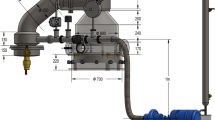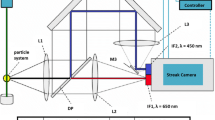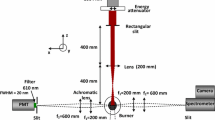Abstract
The influence of oxygen concentration and CO2 as diluent in oxidizer side on soot characteristics was studied by Laser Induced Incandescence, Time Resolved LII and Transmission Electron Microscopy photography in non-premixed coflowing flames. Through the comparison of TEM photographs and the decay rate of LII signal, suitable two delay times of TIRE-LII method and signal sensitivity (ΔS TIRE - LII /Δ) were determined. The effects of O2 and CO2 as diluent in oxidizer side on soot formation are investigated with these calibrated techniques. The O2+CO2, N2, and [Ar+CO2] mixture in co-flow were used to isolate CO2 effects systematically. The number concentration of primary particle and soot volume fraction abruptly decrease by the addition of CO2 to the co-flow. This suppression is resulted from the short residence time in inception region because of the late nucleation and the decrease of surface growth distance by the low flame temperature due to the higher thermal capacity and the chemical change of CO2 including thermal dissociation. As the oxygen concentration increases, the number concentration of soot particles at the inception region increases and thus this increase of nucleation enhances the growth of soot particle.
Similar content being viewed by others
References
Angrill, O., Geitlinger, H., Streibel, T., Suntz, R. and Bockhorn, H., 2000, “Influence of Exhaust Gas Recirculation on Soot Formation in Diffusion Flames,” Proc. Combust. Instit. 28, pp. 2643.
Bonczyk, P. A., 1983, “In-situ Optical Measurement of Additive Effects on Particulates in a Sooting Diffusion Flame,” Combust. Flame 51, pp. 219.
Du, D. X., Axelbaum, R. L. and Law, C. K., 1990, “The Influence of Carbon Dioxide and Oxygen as Additives on Soot Formation in Diffusion Flames,” Proc. Combust. Instit. 23, pp. 1501.
Glassman, Irvin, 1998, “Sooting Laminar Diffusion flames: Effect of Dilution, Additives, Pressure, and Microgravity,” Proc. Combust. Inst. 27, pp. 1589.
Gulder, Ö. L., 1995, “Effects of Oxygen on Soot Formation in Methane, Propane, and n-Butane Diffusion Flames,” Combust. Flame 101, pp. 302.
Iuliis, S. De, Cignoli, F., Benecchi, S. and Zizak, G., 1998, “Investigation of the Similarity of Soot Parameters in Ethylene Diffusion Flames with Different Heights by Extinction/Scattering Technique,” Proc. Combust. Instit. 27, pp. 1549.
Iuliis, S. De, Barbini, M., Benecchi, S., Cignoli, F. and Zizak, G., 1998, “Determination of the Soot Volume Fraction in an Ethylene Diffusion Flame by Multiwavelength Analysis of Soot Radiation,” Combust. Flame 115, pp. 253.
Lapuerta, M., Salavert, J. M. and Domenech, C, “Modelling and Experimental Study about the Effect of Exhaust Gas Recirculation on Diesel Engine Combustion and Emission,” SAE paper 95–0216.
Liu, F., Guo, H., Smallwood, G. J. and Gulder, O. L., 2001, “The Chemical Effects of Carbon Dioxide as an Additive in an Ethylene Diffusion Flame: Implications for Soot and NOx Formation,” Combust. Flame 125, pp. 778.
Melton, L. A., 1984, “Soot Diagnostics Based on Laser Heating,” Appl. Opt. 23, pp. 2201.
Ni, T., Gupta, S. B. and Santoro, R. J., 1994, “Suppression of Soot Formation in Ethane Laminar Diffusion Flames by Chemical additives,” Proc. Combust. Instit. 25, pp. 585.
Ni, T., Pinson, J. A., Gupta, S. and Santoro, R. J., 1995, “Two-dimensional Imaging of Soot Volume Fraction by the Use of Laser-Induced Incandescence,” Appl. Opt. 34, pp. 7083.
Quay, B., Lee, T. W., Ni, T. and Santoro, R. J., 1994, “Spatially Resolved Measurements of Soot Volume Fraction Using Laser-Induced Incandescence,” Combust. Flame 97, pp. 384.
Santoro, R. J., Yen, T. T., Horvath, J. J. and Semerjian, H. G., 1987, “The Transport and Growth of Soot Particles in Laminar Diffusion Flames,” Combust. Sci. and Tech. 53, pp. 89.
Santoro, R. J. and Semerjian, H. G., 1984, “Soot Formation in Diffusion Flames: Flow Rate, Fuel Species and Temperature Effects,” Proc. Combust. Instit. 20, pp. 997.
Santoro, R. J., Semerjian, H. G. and Dobbins, R. A., 1983, “Soot Particle Measurements in Diffusion Flames,” Combust. Flame 51, pp. 203.
Schraml, S., Dankers, S., Bader, K., Will, S. and Leipertz, A., 2000, “Soot Temperature Measurements and Implications for Time-Resolved Laser-Induced Incandescence (TIRE-LII),” Combust. Flame 120, pp. 439.
Shaddix, C. R., Harrington, J. E. and Smyth, K. C., 1994, “Quantitative Measurements of Enhanced Soot Production in a Flickering Methane/Air Diffusion Flame,” Combust. Flame 99, pp. 723.
Shimazaki, N., Hatanak, H., Yokota, K. and Nakahira, T., “Study of Diesel Combustion Process under the Condition of EGR and High-Pressure Fuel Injection with Gas Sampling Method,” SAE paper 96–0030.
Tree, D. R. and Foster, D. E., 1994, “Optical Soot Particle Size and Number Density Measurements in a Direct Injection Diesel Engine,” Combust. Sci. and Tech. 95, pp. 313.
Vander Wal, R. L., Ticich, T. M. and Stephens, B., 1999, “Can Soot Primary Particle Size be Determined Using Laser-Induced Incandescence?,” Combust. Flame 116, pp. 291.
Will, S., Schraml, S. and Leipertz, A., 1996, “Comprehensive Two Dimensional Soot Diagnostics Based on Laser-Induced Incandescence (LII),” Proc. Combust. Instit. 26, pp. 2277.
Will, S., Schraml, Bader, S. K. and Leipertz, A., 1998, “Performance Characteristics of Soot Primary Particle Size Measurements by Time-Resolved Laser-Induced Incandescence,” Appl. Opt. 37, pp. 5647.
Zhang, C., Atreya, A. and Lee, L., 1992, “Sooting Structure of Methane Counterflow Diffusion Flames with Preheated Reactants and Dilution by Products of Combustion,” Proc. Combust. Instit. 24, pp. 1049.
Author information
Authors and Affiliations
Corresponding author
Rights and permissions
About this article
Cite this article
Oh, K.C., Shin, H.D. The effect of oxygen and carbon dioxide concentration on soot formation in nonpremixed flames using time resolved LII technique. J Mech Sci Technol 19, 2068–2076 (2005). https://doi.org/10.1007/BF02916500
Received:
Revised:
Issue Date:
DOI: https://doi.org/10.1007/BF02916500




